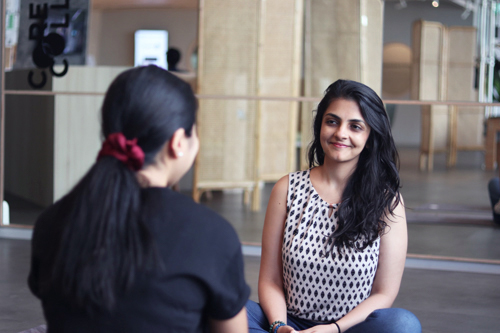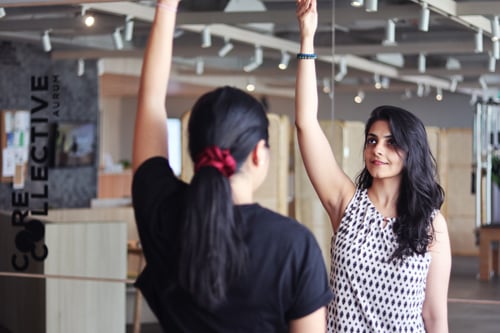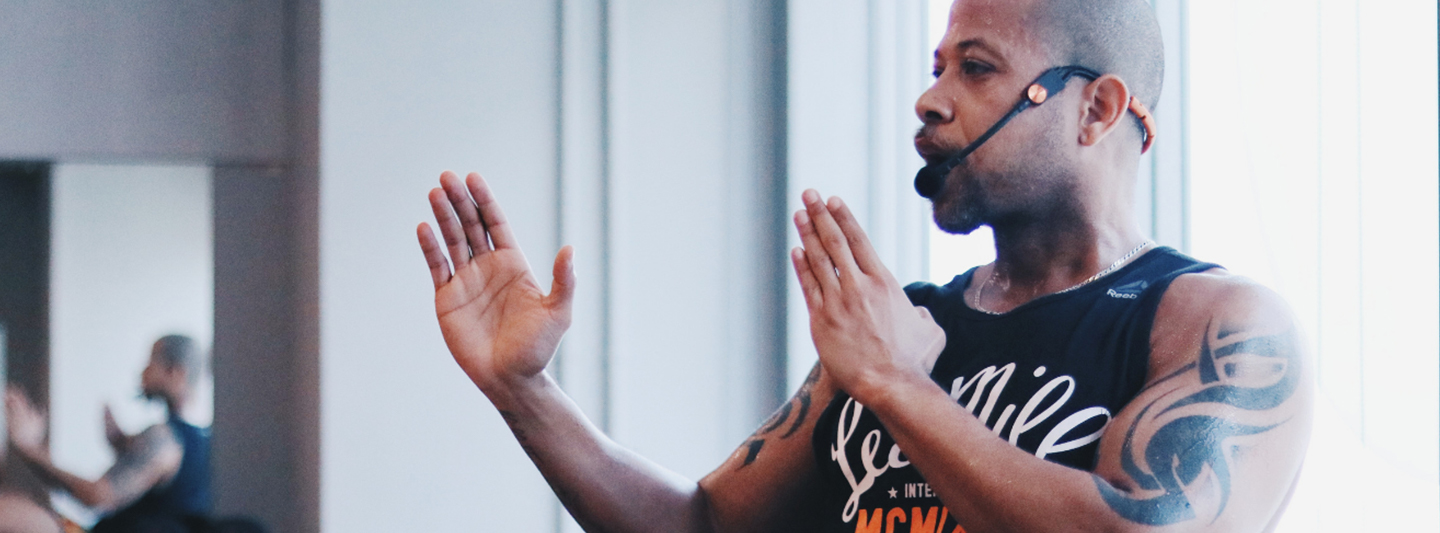I first noticed the dull pain on the right side of my waist which occasionally extended down to the right foot. I was 22 and finishing my final year of University in Sydney. I attributed the pain to my long hours of working on my feet while doing my part-time work in a pie and coffee shop.
The pain didn’t get better and I decided to seek help from a chiropractor and a massage therapist. The pain was mostly bearable so I went on and coped thinking that it would eventually subside with all the help I was getting.
Eventually, my University year ended and it was time to return home. At the time, home was in Jakarta, Indonesia. I recall with clarity the sense of uncertainty on what would I do next in life. The sense of not knowing and not having a plan at the time brought a great amount of stress and anxiety. To add on to that, life in Sydney had been so refreshing and novel in many ways that letting it go felt like an enormous loss.
With the increasing level of stress and confusion, the physical pain intensified. The pain seemed to have spread all the way to my upper body and neck area. First, it was centered in the right side of the body but soon enough it spread to the left side. I decided I need to take the pain seriously because it was beginning to interrupt my daily life. I could not focus on a task, I felt extremely tired and getting out of bed became difficult. I would force myself out of bed because I felt better when I was more active. However, during the day, especially during the late afternoon, I could not concentrate and I kept taking breaks from work.
During my time in Jakarta, I sought help from different professionals. I met with different specialists, I went to a physiotherapist, chiropractor and massage therapist regularly. The therapy would help temporarily but the pain returned. There was no conclusive response medically either.
With each day, I became more desperate. I was concerned that this pain will take over my life and that I may be suffering from something serious and undetected. With these thoughts interrupting my life regularly, the anxiety symptoms took its toll. I was finding it hard to sleep, I was feeling low most of the time and my appetite had changed. I was grateful for some of the support I received from a clinical nurse who was also a massage therapist. She reassured me that I will find a way out of this and it was a matter of time.
Shortly after, I was advised to see a pain care specialist. A relative I knew sent me an article of someone who was suffering from similar symptoms of unexplained pain and she had received help this way.
I came to Singapore to meet a pain care specialist. After running a few tests, he was quick to diagnose it as fibromyalgia, a condition that entailed chronic inflammation and muscular tenderness especially when triggered by stress or other factors like food and sleep quality.
One part of me was relieved that it wasn't terminal and the other part of me experienced a period of grief. I wanted to be a fit and healthy young person who can work, travel, have a family and live a fulfilling life. The experience of pain at the time made me feel like all of this was going to be difficult to achieve. I asked the doctor if there was any chance that the pain will go away. He said it could be in remission with proper care, medication and attention.
I was diligent with taking medication but in hindsight, I realised I did not know how to care for myself properly and accurately. I haven’t been exercising and when I tried to go the gym, my muscles would feel incredibly sore the next day that it demotivated me to continue to exercise. However, with enough support from the clinical nurse therapist and support from my sister, I did what I could and eventually came off medication after one year. Life started to look promising again and I made plans to move to Singapore more permanently.
Two years later, a few months into my Master’s Degree, the symptoms returned again. I went back to my doctor and was put on medication. He reminded me that I need to keep my stress levels low. It was a good suggestion, but I could hardly stop feeling anxious about what is going to happen next. I tried to exercise again, planned my work and study in a way that allows for plenty of free time. However, it didn’t stop the physical symptoms of anxiety and the intrusive thought that this pain is going to eventually take over my life and because of it, I would not be able to cope in other areas of life. The constant sense of anxiety had also put a strain on my relationship and from a source of support, the relationship became a space of stress and worry.
The difference this time is that I was pursuing my education and working in the field of mental health. In the process of learning and practicing, I soon discovered that there are significant overlap in the symptoms between chronic pain syndrome and in mental health issues. Not only did the symptoms overlap, the prescribed medication overlaps too.
I was also captivated by the successful results of certain studies conducted on the practice of mindfulness, yoga and other movement-based therapy for the overlapping symptoms of chronic pain syndrome and mental health. At that time, I followed my intuition to keep reading, learning and following the practice suggested by the above therapeutic model.
After a couple of years of doing this, I experienced a significant shift in my symptoms when I started practicing yoga more regularly. The dull ache went away, the brain fog I experienced in the day time reduced significantly and I was filled with hope that there is a way to live that can help us improve both our physical and mental wellness.

I began to learn that our body has the incredible and profound capacity to safely contain distressing emotions (e.g anxiety, worry, fear, grief, loss, anger, frustration, hopelessness, and more) through the process of breathing awareness, movement awareness and through the purposeful release of the distress. When we connect our state of mind to the practices and sensations of our body, what I find is that we no longer feel so overwhelmed and out of control because we know what we can do to move back into a state of equilibrium.
Now, when working with my clients and patients, I choose to keep in mind how the body is influencing the mind and vice versa. In my practice, when the time is appropriate, I facilitate sessions for my clients where they are able to reconnect the mind and body in a way that is comfortable for them.
I also facilitate Body Movement Therapy in small groups. Those who come to this group are helped to use movements that are based on yoga principles, mindfulness practices and somatic therapy to begin to connect with the body. The small group setting is created with the intention to provide the participants with a therapeutic place to reconnect, recharge and recover from symptoms and pain. Unlike a class setting, I don’t teach ‘correct’ movement or postures. What I do in these sessions is to demonstrate movement and give you space to adjust to it in your own time. I facilitate this way because I firmly believe in the wisdom of our body; our body has journeyed with us through life and when we learn to reconnect, our body becomes a friend in our healing process so what we need to learn to do is to strengthen the connection.
If you are interested to know more about these sessions or if you would like to join, then you can read more here.
With careful research and study, I found that the symptoms of chronic pain that I had and the symptoms from mental health issues stems from a nervous system that is operating out of balance. While the actual cause of this still needs a lot of research, the research literature on mindfulness and movement shows clear evidence on how these two practices alleviate the symptoms of both these conditions.

Around the time of looking more deeply into research and my own health, I had an intuition to begin practicing yoga. I was nervous about the pain that would return so I took more charge of my practice. I practiced the forms of yoga at the level of my comfort and ability. While it is typical for yoga classes to encourage us to maximise our strength and flexibility, I was much more persistent to take my time with the movement given my history of pain. To my surprise (and great happiness I must say), I was able to stretch myself without pain and with greater ease with time, patience and support. Eventually, I felt better and I experimented going without medication for a few days. I felt completely fine. In a matter of months, I stopped all prescribed medication. I was also much more attuned to the needs of my body for sleep, for healthier choices of food, building positive support systems and engaging in activities that support my well-being.
Having experienced the enormous benefit of using movement, I studied in greater depth the impact of movement on the body and how to put it into application for patients and clients going through chronic pain syndrome or mental health symptoms.
Today, I have introduced Body Movement Therapy into my mental health practice. I see clients individually and I have opened up space for small groups to experience the incredible benefit of movement which serves an important function of reconnecting the mind and body. Movement is a safe and non-invasive way that supports recovery, de-stressing process and a rejuvenation experience for those seeking a therapeutic space to recover.
Find out more about Professional Counselling & Psychotherapy today!
Contributor:

Deepika Mulchandani is a registered relationship counsellor and psychotherapist. She completed her Master Degree in Social Science (Professional Counselling) from Swinburne University of Technology. She is also trained in child-centred play therapy and in Theraplay®.
Deepika has consciously chosen to develop her expertise in the area of mind-body connection and in relationship counselling. She firmly believes that the connection we experience with our physical bodies and the quality of relationships we are in greatly determine our mental health and quality of life. Drawing from her training in family and systemic therapy and in mindfulness-based cognitive therapy, Deepika has worked extensively with individuals, couples, parents and children to empower them to improve their connections and live within more fulfilling relationships.
Deepika’s primary areas of focus and interest include, but are not limited to, mental health symptoms like depression, anxiety, eating disorders, chronic pain and other emotional difficulties associated with prolonged distress in the body and in key relationships in life. The foundation of her work is based on research and studies in various aspects of psychology including neuroscience. She is positive about the latest discovery in neuroscience which believes in our brain’s capacity to adapt in a way that allows for greater possibilities of healing and recovery.
As an independent consultant, Deepika has worked in the field of mental health in various professional settings including a residential treatment centre, community organisations, schools, corporations and a healthcare network centre for more than 10 years. She remains steadfast in her commitment towards building healthier communities and continues to be involved with community organisations in Singapore as a consultant and counsellor for children and families.
Deepika is a professional member of the Australian Association of Family Therapy (AAFT) and a clinical member with the Singapore Association for Counselling (SAC). She is the founder of The Open Connections, a counselling and consultation service dedicated to improving mental health and well-being of individuals, families and communities.




